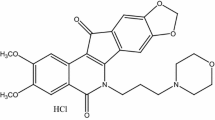Summary
Carminomycin was administered to four dogs and two human patients as a single intravenous dose. Plasma samples were obtained and assayed for carminomycin and carminomycinol by high pressure liquid chromatography with fluorescence detection. The plasma disappearance of carminomycin could be described by a three-compartment open model. Distribution was rapid and the apparent volume of distribution was greater than 100 l/m2 in both species. The terminal half-life of drug was 86 h in dogs and 20 h in humans. In both dogs and humans carminomycinol concentrations rapidly surpassed carminomycin levels, and terminal half-lives were longer than for the parent compound in the two species. Since carminomycinol has antitumor activity and host toxicity, this metabolite may play an important role in the efficacy and toxicity of carminomycin therapy.
Similar content being viewed by others
References
Abele R, Rozencweig M, Reich SD, Lenaz L (1980) Phase I clinical trial of IV carminomycin. Proc Am Assoc Cancer Res/ASCO 21: 329
Andrews PA, Brenner DE, Chou FE, Kubo H, Bachur NR (1980) Facile and definitive determination of human adriamycin and daunorubicin metabolites by high-pressure liquid chromatography. Drug Metab Dispos 8: 152–156
Averbuch SD, Fandrich SE, Finkelstein TT, Reich SD (1981) Anthracycline assay by high pressure liquid chromatography. J Pharm Sci 70: 265–268
Bachur NR (1976) Cytoplasmic aldo-keto reductases: A class of drug metabolizing enzymes. Science 193: 595–597
Baker LH, Kessel DH, Comis RL, Reich SD, DeFuria MD, Crooke ST (1979) American experience with carminomycin. Cancer Treat Rep 63: 899–902
Berrman M, Weiss MF (1977) SAAM27 (Simulation, Analysis, and Modeling) user's manual. U.S. Department of Commerce, National Technical Information Service, Washington (PB-276 751)
Cassinelli G, Grein A, Masi P, Suarato A, Bernardi L, Arcamone F, DiMarco A, Casazza AM, Pratesi G, Soranzo C (1978) Preparation and biological evaluation of 4-0-demethyldaunorubicin (carminomycin I) and of its 13-dihydro derivative. J Antibiot (Tokyo) 31: 178–184
Comis RL, Ginsberg SJ, Crooke ST (1980) A phase I study of carminomycin administered by intravenous bolus every 4 weeks. Proc Am Assoc Cancer Res/ASCO 21: 333
Comis RL, Ginsberg SJ, Reich SD, Baker LH, Crooke ST (1981) Available data from carminomycin studies in the United States: The acute intermittent intravenous schedule. Recent Results Cancer Res 76: 16–20
Crooke ST (1977) A review of carminomycin — A new anthracycline developed in the USSR. J Med 8: 295–316
Gauze GF (ed) (1979) The antineoplastic antibiotic, carminomycin and its clinical applications. Academy of Medical Science (USSR), Moscow
Povarov LS, Shorin VA, Bazhanon VS, Shepelevtseva NG (1976) Production of dihydrocarminomycin and comparison of its antitumor activity with the activity of carminomycin. Antibiotiki 21: 1008–1011
Author information
Authors and Affiliations
Rights and permissions
About this article
Cite this article
Reich, S.D., Fandrich, S.E., Finkelstein, T.T. et al. Pharmacokinetics of carminomycin in dogs and humans. Cancer Chemother. Pharmacol. 6, 189–193 (1981). https://doi.org/10.1007/BF00262341
Received:
Accepted:
Issue Date:
DOI: https://doi.org/10.1007/BF00262341




